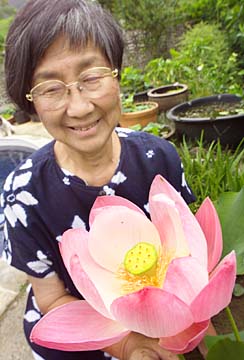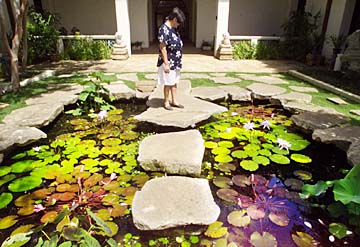


Home & Garden![]()

|
Grandpa Minesaburo Yamachika was a man of good taste with a particular eye toward turning trash into treasure. He was a good gardener, too, who cultivated orchids and bonsai plants. Waterful touch
Betsy Sakata's knack for water
gardening was handed down to her
by her teacher, Grandpa YamachikaHis special touch made his garden in Waimea, Kauai, the most enchanting playground, recalls granddaughter Betsy Sakata.
"He was a very interesting man. He collected all kinds of unusual things that other people didn't think could be used for anything," she says, recalling odd rocks and stone gristmills that the former Singer sewing machine dealer gathered for his garden.
When he wanted a water feature, he didn't settle for a simple container with some plants. He had a craftsman make him a hexagon cement container, which he turned into a small pond anchored by an elaborate bonsai arrangement in the center.
Grandpa Yamachika crafted the bonsai out of an old tree stump, covering it with ferns, moss and miniature ceramic houses and figurines. In the water, he grew water hyacinths and colorful goldfishes.

|
"I remember that well. I wasn't big enough to reach the top of the pond but I was hanging on the side to peek inside at the kinyo (goldfish)," Sakata says.As a child, she didn't fully appreciate her grandfather's uncommon touch -- she took his fragrant and artfully arranged environment all for granted. But in her retirement years, Sakata has not only discovered an artistic kinship with him but also picked up where he left off. (The two also share the same Japanese name. Sakata's name, Mineko, is the female version of his name.)
"I definitely take after him," says Sakata, who has launched into water gardening with a passion since she retired in 1991 from the University of Hawaii as the associate dean of summer session for the Manoa campus.
The hexagonal container (without the bonsai) is sitting in her front yard, paying homage to grandpa Yamachika and becoming part of Sakata's endless experiments with water gardening. Grandpa's collection of rocks and stone containers are spread throughout her Kailua garden, sharing space with her own collection of odd garden finds.
Sakata learned about water gardening partly through her university administrative duties. She sat in on meetings as the university tried to revive the historical Krauss Hall courtyard pond designed by noted island landscaper Richard Tong.
"I never got to practice any of it but I learned about what worked and what didn't work, and I tucked away that little knowledge in the back of my head," she said.
After she retired, Sakata began searching for water garden materials, focusing on water lilies. Those flowering plants were difficult to come by in Hawaii, but eventually Sakata hooked up with aquatic plant enthusiasts on the mainland and Asia and began collecting and trading plants with them.
Sakata has visited Asia, where she's helping to import tropical water lilies from Thailand. She has -- practically single-handedly -- made the once rare water lilies a common sight in Oahu garden stores. Her collection has expanded to include other exotic aquatic plants, such as large calla lilies from Africa.
"Part of the joy of raising these water plants is being able to share the plant and the information. What's the point of keeping everything for yourself? The fun is to get it out there where everybody can see how beautiful a water garden can be," Sakata says.
She has taught water gardening classes and given plants to curious gardeners. Her classes were held at Lyon Arboretum, but she's taking time off from teaching. Call the arboretum to inquire about other aquatic gardening classes, 988-0456.
Sakata volunteers her services -- designing, advising, maintaining and supplying an array of water plants -- for free to public water gardens. Her public projects include the koi ponds at Ala Moana Shopping Center, the Joanna Lau Sullivan Chinese Garden at the Honolulu Academy of Arts, Krauss Hall at the university and Lyon Arboretum.
Creating a water garden isn't difficult, she says. It need not be elaborate; a simple container, such as an old salad bowl, can be transformed into an attractive garden feature.
Choose a container that is at least 18 inches deep. If it's too shallow, sunlight penetrates easily and promotes algae growth, Sakata advises. Chemicals and electrical pumps aren't necessary. Instead, she advocates a natural system, allowing the plants and aquatic animals to create a naturally harmonious environment.

|
"There are people who scrub their pots every week, and that just drives me nuts," says Sakata, who warns that the scrubbing takes away the good bacteria essential to the living water floral and fauna."Don't forget, you're going to get toads whether you like it or not. If there's water, there's going to be toads. They just show up," she warns.
Toads are good for a water garden. They control insects and add to the harmony. Pick small fish, such as colorful guppies, to add color and also to control mosquitos, she says. Throw in some snails to control algae. Surface plants, like duck weed, help cover the water surface and control algae growth also.
Be sure to include a grass plant with flowering plants, she says. Grass plants produce oxygen for the water and help keep the fish and other animals healthy.
When choosing water lilies, keep in mind the requirements and growth patterns of the plants. The temperate lilies, like those in Monet's famous paintings, crawl on the water surface and should be placed at the edge of the container to allow them room to roam. The tropical lilies, such as the brilliant purple King of Siam, should be placed in the center of the pot. The leaves of the tropical lilies radiate from the pot into a circular pattern and the flower stalks rise above the water for showy blooms.
Gardening Calendar
Suzanne Tswei's gardening column runs Fridays in Today.
You can write her at the Star-Bulletin,
500 Ala Moana, Suite 7-210, Honolulu, HI, 96813
or email stswei@starbulletin.com